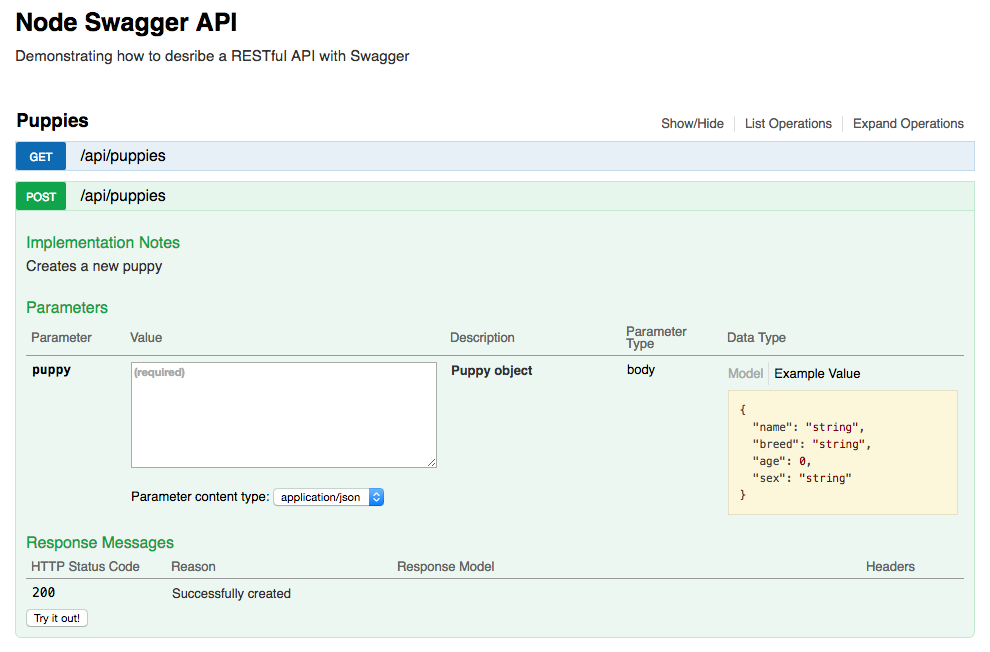目标:
1.描述Swagger的目的
2.基于使用Node、Express和Postgres开发的现有RESTful API生成Swagger规范
3.设置Swagger UI以测试API并与之交互
介绍:
Swagger 是用于描述、生成、使用、测试和可视化 RESTful API的规范。它提供了许多用于基于给定端点自动生成文档的工具。现在,当您对代码进行更改时,您的文档会更新并与 API 同步,以便消费者可以快速了解哪些资源可用、如何访问它们,以及何时发生的预期(状态代码、内容类型等)与各种端点进行交互。
Swagger是世界上最大的面向OpenAPI规范(OAS)的API开发工具框架,支持跨整个API生命周期的开发,从设计和文档,到测试和部署。
生成Swagger规范:
为了生成Swagger规范,我们将使用swagger-jsdoc。
安装swagger-jsdoc:
npm install swagger-jsdoc@1.3.0 --save
将swagger-jsdoc添加到app.js中:
var swaggerJSOoc=reguire('swagger-jsdoc');
将下面的代码添加到express创建之后:(var app=express();)
1 // swagger definition 2 var swaggerDefinition = { 3 info: { 4 title: 'Node Swagger API', 5 version: '1.0.0', 6 description: 'Demonstrating how to describe a RESTful API with Swagger', 7 }, 8 host: 'localhost:3000', 9 basePath: '/', 10 }; 11 12 // options for the swagger docs 13 var options = { 14 // import swaggerDefinitions 15 swaggerDefinition: swaggerDefinition, 16 // path to the API docs 17 apis: ['./routes/*.js'], 18 }; 19 20 // initialize swagger-jsdoc 21 var swaggerSpec = swaggerJSDoc(options);
注意上面的注解。这段代码实际上初始化了Swagger -jsdoc,并将适当的元数据添加到Swagger规范中。
添加路由以提供 Swagger 规范:
1 // serve swagger 2 app.get('/swagger.json', function(req, res) { 3 res.setHeader('Content-Type', 'application/json'); 4 res.send(swaggerSpec); 5 });
启动服务器并导航到http://IP:端口/swagger.json以查看基本规范:
{ "info": { "title": "Node Swagger API", "version": "1.0.0", "description": "Demonstrating how to describe a RESTful API with Swagger" }, "host": "localhost:3000", "basePath": "/", "swagger": "2.0", "paths": { }, "definitions": { }, "responses": { }, "parameters": { }, "securityDefinitions": { } }
更新路由处理程序:
swagger-jsdoc 使用JSDoc样式的注释来生成 Swagger 规范。因此,在 YAML 中将此类注释添加到描述其功能的路由处理程序中。
在处理程序上方的/routes/index.js 中添加注释,如下所示:
/** * @swagger * /api/puppies: * get: * tags: * - Puppies * description: Returns all puppies * produces: * - application/json * responses: * 200: * description: An array of puppies * schema: * $ref: '#/definitions/Puppy' */ router.get('/api/puppies', db.getAllPuppies);
在之前的代码上方添加以下代码:
/** * @swagger * definitions: * Puppy: * properties: * name: * type: string * breed: * type: string * age: * type: integer * sex: * type: string */
现在我们可以为每个 HTTP 方法使用该定义。
有关更多信息和示例,请参阅Swagger 规范。
get:
/** * @swagger * /api/puppies/{id}: * get: * tags: * - Puppies * description: Returns a single puppy * produces: * - application/json * parameters: * - name: id * description: Puppy's id * in: path * required: true * type: integer * responses: * 200: * description: A single puppy * schema: * $ref: '#/definitions/Puppy' */
post:
/** * @swagger * /api/puppies: * post: * tags: * - Puppies * description: Creates a new puppy * produces: * - application/json * parameters: * - name: puppy * description: Puppy object * in: body * required: true * schema: * $ref: '#/definitions/Puppy' * responses: * 200: * description: Successfully created */
put:
/** * @swagger * /api/puppies/{id}: * put: * tags: Puppies * description: Updates a single puppy * produces: application/json * parameters: * name: puppy * in: body * description: Fields for the Puppy resource * schema: * type: array * $ref: '#/definitions/Puppy' * responses: * 200: * description: Successfully updated */
delete:
/** * @swagger * /api/puppies/{id}: * delete: * tags: * - Puppies * description: Deletes a single puppy * produces: * - application/json * parameters: * - name: id * description: Puppy's id * in: path * required: true * type: integer * responses: * 200: * description: Successfully deleted */
添加完成后,在http://IP:端口/swagger.json查看更新的规范。
添加 Swagger UI
最后,下载Swagger UI repo,将下载的repo 中的“dist”文件夹添加到项目目录中的“public”文件夹中,然后将目录重命名为“api-docs”。
现在在“api-docs”目录内的index.html 中只需更新这一行,将:
url = "http://petstore.swagger.io/v2/swagger.json";
改成:
url = "http://localhost:3000/swagger.json";
最后,在浏览器中导航到http://IP:端口/api-docs/以测试 API 端点:

parameters.yaml配置:
#必要字段!Swagger规范版本,必须填2.0,否则该YAML将不能用于Swagger其他组件 swagger: '2.0' #必要字段!描述API接口信息的元数据 info: #接口标题 title: swagger说明文档 #接口文档的描述 description: 学习Swagger #版本号 version: 1.0.0 #Swagger会提供测试用例,host指定测试时的主机名,如果没有指定就是当前主机,可以指定端口. host: 127.0.0.1 #定义的api的前缀,必须已/开头,测试用例的主机则为:host+bashPath basePath: /api #指定调用接口的协议,必须是:"http", "https", "ws", "wss".默认是http.-表示是个数组元素,即schemes接受一个数组参数 schemes: - http - https #对应与http协议头request的Accept,调用者可接受类型,默认是*/*,定义的类型必须是http协议定义的 Mime Types,RestfulAPI一般定义成application/json #这两个是对所有接口的全局设置,在细化的接口中是还可以对应这两个属性来覆盖全局属性 produces: - application/json #必要字段!定义可有可操作的API paths: /users: #必要字段!定义HTTP操作方法,必须是http协议定义的方法 get: #接口概要 summary: 查询所有用户信息 #接口描述 description: 查询出所有用户的所有信息,用户名,别名 #标签,方便快速过滤出User相关的接口 tags: - User #返回值描述,必要自动 responses: #返回的http状态码 200: description: 所有用户信息或者用户的集合信息 #描述返回值 schema: #返回值格式,可选的有array,integer,string,boolean type: array #针对array,每个条目的格式,type定义为array.必要填写items items: #引用在definitions下定义的Users $ref: '#/definitions/User' #执行出错的处理 default: description: 操作异常,执行失败.返回信息描述错误详情 schema: #值类型 type: object #定义属性 properties: #属性名 message: #类型 type: string #即对于同一个url定义两个不同的方法,表示两个接口 post: description: 注册一个用户 #请求参数 parameters: #参数key - name: username #传递方法,formData表示表单传输,还有query表示url拼接传输,path表示作为url的一部分 #body表示http头承载参数(body只能有一个,有body不能在有其他的) in: formData #参数描述 description: 用户名,不能使用已经被注册过的 #参数是否必要,默认false required: true #参数类型,可选的包括array,integer,boolean,string.使用array必须使用items type: string - name: password in: formData description: 用户登陆密码,加密传输,加密存储 required: true type: string - name: alias in: formData type: string description: 用户别名 #非必要字段 required: false responses: #返回的http状态码 200: description: 通过返回值来标示执行结果 返回true表示执行成功 schema: #值类型 type: object #定义属性 properties: #属性名 status: #类型 type: boolean #描述 description: 是否成功 #执行出错的处理 default: description: 操作异常,执行失败.返回信息描述错误详情 schema: #值类型 type: object #定义属性 properties: #属性名 message: #类型 type: string /users/{id}: #{id}表示id为请求参数,例如/users/1,/users/2都是对该API的请求,此时id即为1和2 get: summary: 根据用户名id查询该用户的所有信息 description: 查询出某个用户的所有信息,用户名,别名等 tags: - User parameters: #上面接口中定义了{id},则参数列表中必须包含参数id,并且请求类型为path - name: id in: path description: 要查询的用户的用户名,它是唯一标识 required: true type: string responses: 200: description: 所有用户信息或者用户的集合信息 schema: $ref: '#/definitions/User' default: description: 操作异常,执行失败.返回信息描述错误详情 schema: #值类型 type: object #定义属性 properties: #属性名 message: #类型 type: string #http定义的delete方法,删除一个资源 delete: summary: 删除用户 description: 删除某个用户的信息,被删除的用户将无法登陆 parameters: - name: id in: path type: string required: true description: 用户的唯一标示符 tags: - User responses: 200: description: 通过返回值来标示执行结果 返回true表示执行成功 schema: #值类型 type: object #定义属性 properties: #属性名 status: #类型 type: boolean #描述 description: 是否成功 default: description: 操作异常,执行失败.返回信息描述错误详情 schema: #值类型 type: object #定义属性 properties: #属性名 message: #类型 type: string #描述错误信息 #http定义的patch方法,表示修改一个资源 patch: summary: 用户信息修改 description: 修改用户信息(用户名别名) parameters: - name: id in: path description: 用户名,要修改的数据的唯一标识符 required: true type: string - name: alias in: formData description: 新的用户别名 required: true type: string tags: - User responses: 200: description: 通过返回值来标示执行结果 返回true表示执行成功 schema: #值类型 type: object #定义属性 properties: #属性名 status: #类型 type: boolean #描述 description: 是否成功 default: description: 操作异常,执行失败.返回信息描述错误详情 schema: #值类型 type: object #定义属性 properties: #属性名 message: #类型 type: string #描述错误信息 definitions: User: #值类型 type: object #定义属性 properties: #属性名 id: #类型 type: string #描述 description: 用户的唯一id username: type: string description: 用户名 alias: type: string description: 别名



 浙公网安备 33010602011771号
浙公网安备 33010602011771号